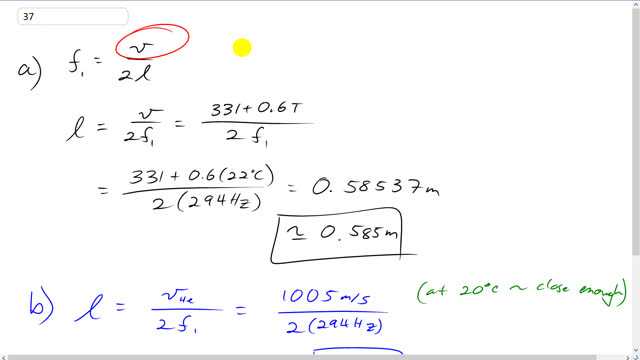
- At , how long must an open organ pipe be to have a fundamental frequency of 294 Hz?
- If this pipe is filled with helium, what is its fundamental frequency?
- . Note: the video needs a remake for part (b), so please see the comment below the video where I explain how to calculate the fundamental frequency when the tube is filled with helium.

In order to watch this solution you need to have a subscription.
This is Giancoli Answers with Mr. Dychko. The fundamental frequency for a tube will open at both ends is the wave speed which is the speed of sound since the thing that's resonating here is air inside the tube. And so the wave is moving through air which is a wave moving which is what sound is, a wave moving through air. So, we have v over 2 l and we'll solve for l, the length, we're multiplying by l over f1 on both sides. And we get l on the left equals v divided by 2 times the fundamental frequency on the right side so, that's l equals 331 plus 0.6 times the temperature over 2 f1, because this is the formula for the speed of sound as a function of temperature in Celsius degrees. So, we have 331 plus 0.6 times 22 degrees Celsius divided by 2 times 294 hertz which is a length of 0.585 meters. Now, if helium was inside the tube, the reason that helium makes a difference is because the speed of sound in helium is different. And table 12-1 tells us the speed of sound in helium at 20 degrees Celsius. And well that's close enough, I mean, we're working with 22 degrees but 20 is pretty close. So, we'll use the same figure because we don't have any formula to figure out the speed any other way. So, the length is going to be 1,005 meters per second divided by 2 times 294 hertz. And that's going to give a length of 1.71 meters would be required.
I believe that part B ask for the new fundamental frequency having the pipe filled with Helium, would you mind double checking.
Hi markinthedark, yes, nice catch. I recalculated the length with helium rather than recalculating the fundamental frequency. To find the fundamental frequency of an open ended tube, with the length calculated in part (a) as , and the speed of sound in helium as (this is a number I just had to look up), the fundamental frequency is . I've flagged the video to update it one day, and I'll post a note in the quick answer section. Let me know if you still have any questions about this problem.
Hope this helps,
Mr. Dychko